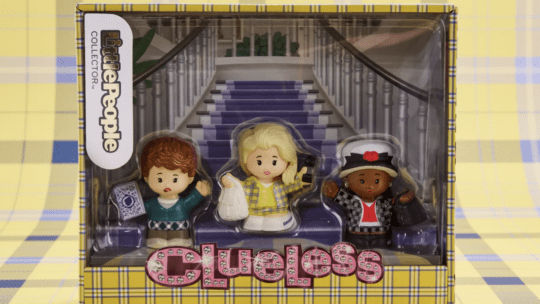
This week's PR Roundup looks at lessons from the Elmo account hack on X, a new reputation risk survey that compares Europe and the United States, and Clueless celebrating a big anniversary with some fun, inventive swag for all ages.
Elmo X Hack and the Crisis of Platform Trust
What happened: Everybody has bad days. Even Elmo.
Last weekend little Elmo became the latest celebrity to get hacked on social media. The official X account for the beloved "Sesame Street" character was compromised, resulting in a series of disturbing posts containing antisemitic and racist language. The account, which has more than 600,000 followers, was quickly scrubbed of the offensive content.
Sesame Workshop, the nonprofit behind the iconic children’s program, confirmed the breach and issued a statement saying it was working to regain full control of the account, and it has since been secured. The incident showcases the ongoing vulnerability of brand and character accounts—even those designed for children—to malicious digital activity and hate speech.
On Sunday, Elmo’s X account was briefly hacked by an outside party, in spite of the security measures in place.
We strongly condemn the abhorrent antisemitic and racist content, and the account has since been secured.
These posts in no way reflect the values of Sesame Workshop… pic.twitter.com/MaTqsjQ81V
— Elmo (@elmo) July 15, 2025
The hack arrives amid growing concern over the rise in hateful content on X under Elon Musk’s leadership. Over the past several months, Grok—X’s AI chatbot—posted white supremacist language and antisemitic remarks that were later deleted, with the company admitting the bot was echoing extremist user behavior.
Communication takeaways: These incidents can sound alarm bells for communicators tasked with maintaining brand safety and trust on social platforms. For many, the Elmo hack is more than just a moment of bad optics—it’s a stark reminder that even the most wholesome brands can be targeted on today’s volatile digital platforms.
However, there are ways brands can protect themselves and prevent hack damage. Some of that starts with creating a strong brand online from the get-go.
Dayna Castillo, Senior Social Strategist at Calm and Managing Editor at Silence, Brand!, says when Elmo’s account was hacked it was immediately obvious something was off because the posts didn’t sound like Elmo.
“They didn’t match the tone or behavior we’re used to from our beloved children’s character and that mismatch told everyone, this isn’t normal,” Castillo says. “That shows the power of having a clear brand voice on social.”
Castillo says a strong brand voice can create a baseline and familiarity for the audience, something people can recognize and rally around, even when things go sideways.
And if you are hacked? She says having a crisis plan already in place is key.
“Who needs to sign off on post-hack messaging?” Castillo asks. “Who has access to recovery info and platform contacts? Who’s owning communication across channels? Treat it like an earthquake drill. You can’t stop the shaking, but you can decide how you respond.”
Nneka Etoniru, EVP and head of global brand strategy at Avenue Z, says timing is everything during a hack.
“The first priority is containment—secure access, assess the scope and remove offending content,” Etoniru says.
However, she notes, containment isn’t enough. Because the public will immediately demand clarity, accountability and empathy.
“What Sesame Workshop did right was show up quickly, with transparency and values intact,” Etoniru says. “The best defense in these moments is trust, built long before the crisis ever hits.”
Reputation Risk Index Shows Transatlantic Divide
What happened: The latest Reputation Risk Index, released by the Global Situation Room, identified disinformation as the top reputational risk, alongside a growing divide over what sparks public scrutiny on either side of the Atlantic.
At a time of unprecedented transatlantic trade tensions, the Global Risk Advisory Council (a global group of 130+ former heads of state and public affairs executives) survey revealed the top threat confronting companies as disinformation, driven in many cases by polarized political agendas that are increasingly ensnaring the private sector.
Key Findings:
- The top reputational risks from Q2 overall were AI/tech-related: disinformation and data privacy violations. (If a brand were to be associated with either of these topics, the greater the chance for public/media scrutiny).
- European stakeholders expect deeper cultural alignment and sustained values-driven behavior, particularly in areas such as fairness, sustainability and ethics. For this reason, companies in Europe face scrutiny for both what they do and why they do it.
- On the other hand, the top, current U.S. reputational risks come from political entanglements such as affiliations with controversial figures and DEI programs.
“The Index shows organizations operating globally are being put in a difficult spot navigating an expanding divide between Europe and the United States,” says the former Administrator of the U.S. Small Business Administration and Chair of the Global Risk Advisory Council Isabel Casillas Guzman. “Trade impacts are tough. But, what is getting less attention is how consumers, media and leaders in each market are also diverging dramatically in their views.”
Communication takeaways: What earns praise in one market can provoke backlash in another, as seen in the differences between Europe and the United States in this survey. However, all companies are being forced to thread a fast-narrowing needle—actions on climate and DEI, for example.
Brett Bruen, President, Global Situation Room, says toxic politics are starting to pollute the waters for brands, with disinformation coming through as a major danger.
"Organizations need to double down on messaging that can overcome congested, chaotic communications contexts,” he says. “They need to create the capability to push back against false narratives that can rapidly damage reputations.”
“Clueless” 30th Anniversary Introduces Collectible Toy Swag for all Ages
What happened: Where were you when the movie “Clueless” debuted in 1995? I, at the risk of aging myself, sat that summer in a darkened, air conditioned theater, weeks before entering my freshman year of high school, inspired by Cher and Dionne to unleash a new, fashionable persona. Some of you may have thought about introducing block-heeled Mary Janes and knee socks into your work wardrobe. Many of you reading this may not have been alive. It solidified many a teenage dream of procuring a cell phone.
“Clueless,” now considered a snapshot of mid-1990s culture and satire, set off the careers of many famous actors including Alicia Silverstone, Paul Rudd, Donald Faison and the late Brittany Murphy. It also blew up a '90s fashion and accessories industry that, at the time, consisted mostly of oversized wide-leg jeans and flannel. (Funny how everything old becomes new again). Feather pens and mini skirts took over as “Clueless” fever rose that summer, signaling a culture shift for the remainder of the '90s.
Its 30th anniversary has also inspired something of a marketing and communications shift—the ability to market movies through products. Sure, Star Wars figurines and Disney-branded video games are nothing new, but “Clueless” is going out on a limb in some surprising toy avenues—which honestly, are not just for kids. Sure, you have the easy interpretation through Mattel and the movie’s Barbie doll line and American Girl dolls and accessories, but other innovative iterations include Fisher Price’s Little People, Polly Pocket (Cher’s white Jeep Wrangler included), and a special UNO card deck, complete with an “As If” Wild card.
Communication takeaways: Some films are more than just films. They create real iconic moments for fashion and language. They do more than just entertain, they embed themselves into the fabric of an era.
Steph Lund, Chief Executive Officer, MSQ Sport + Entertainment, says communicators can do right by celebrating cultural moments like “Clueless,” but with intention.
“As communicators, we have a unique opportunity to tap into this kind of nostalgia—not to commodify it, but to celebrate it,” Lund says. “Done right, these moments allow us to bring joy and levity and celebrate something that had an imprint, even 30 years later. But alignment does matter. It has to feel right. Otherwise, it can miss the mark entirely.”
And it can be a difficult decision to decide if your brand should hop in and participate. It can either be a brilliant pairing, or can land with plenty of cringe.
“[Do] your homework,” Lund says. “Audit the original moment. Analyze the conversation that has lived around it—then and now. What are fans still saying? What meaning does the moment hold today? And where, if anywhere, does your brand naturally fit?”
From there, she advises, act with intention.
“The best cultural alignments are the ones that are rooted in truth and executed with a sense of play, not performance,” Lund says. “Be bold, be thoughtful—and always aim to add to the conversation, not just take.”
Nicole Schuman is Managing Editor at PRNEWS.
